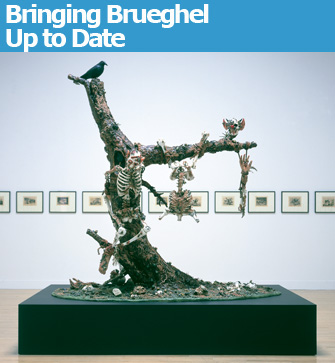 |
|
Jake & Dinos Chapman’s “Sex I” (2003). © Jake & Dinos Chapman. Courtesy White Cube Gallery, London. Photo: Stephen White |
“Memories of the Future,” the current exhibition at the Maison Rouge/Foundation Antoine Galbert, explores certain themes as treated by artists in the past and present with work …
 |
|
Jake & Dinos Chapman’s “Sex I” (2003). © Jake & Dinos Chapman. Courtesy White Cube Gallery, London. Photo: Stephen White |
“Memories of the Future,” the current exhibition at the Maison Rouge/Foundation Antoine Galbert, explores certain themes as treated by artists in the past and present with works from the collection of one man, Thomas Olbricht, a doctor who has an exhibition space called “me collectors room” in Berlin. The themes represented in Paris are death and violence and what might be called horror at the human condition, with one room set aside for representations of women that don’t really fit into the previous three categories. A few abstract paintings – by Gerhard Richter and Sigmar Polke – are thrown in for good measure.
The show starts off with mostly contemporary works, notably Jake and Dino Chapman’s “Sex I” (2003), a large painted-bronze sculpture consisting of bits and pieces of human corpses hanging or fallen from the branches of a dead tree, their rotting flesh crawling with maggots and other vermin, which will make you gag even if you are familiar with their work. The Chapman brothers are, of course, famous for out-grossing Goya, the master they have based many of their works on.
While there are many other individually interesting works in the first half of the show – not least Julie Heffernan’s intricate painting “Self-Portrait as Big World” (2008), in which a saintly-looking woman with a naked torso wears a skirt of dead game and vignettes of men hunting float in the background – the exhibition as a whole doesn’t really pack a wallop until you get to the room painted dark gray, where Old Master paintings, mostly still lifes, meet curiosities of all sorts and contemporary works in a way that really resonates.
Here you’ll find a few of Matt Collishaw’s gorgeously lit Old-Masterly-with-a-twist still-life photos hanging next to real Old Master still lifes. A large glass display case contains some fascinating curiosities as might have been collected by some 18th-century aristocrat (except that some are contemporary, such as the Chapman brothers’ small silver version of the aforementioned “Sex I,” entitled “The Same, but Silver”), among them a tiny anatomical model of a pregnant women in ivory by Stephan Zick (1639-1715), which can be dismantled to see what’s going on inside, and a 17th-century anatomical model of the skull of a syphilis victim, also in ivory. The case also holds a delicate sphere made of mouse skulls by Alistair Mackie, a nice complement to two amazing antique carved spheres within spheres, one of them from China. Other wonderful pieces in this room include Liza Lou’s “Homeostasis” (2005-06), a highly realistic – except that he is completely covered in an intricate pattern of red-and-white beads – statue of a naked man leaning against the wall, and Kate MccGwire’s feather sculptures under glass, which have a real animal presence.
Another entire room, this one painted black, is devoted to various artists’ versions of vanities, those reminders of our mortality in the form of skulls and skeltons. In the basement are the real gross-out pieces, most notably Patricia Piccinini hairy, deformed humanoid creatures.
When you leave, take the time to look at the publisher H. Cock’s prints of Jan Brueghel the Elder’s “The Seven Virtues” (1559-60), which will amply demonstrate that there is nothing new about the “shocking” contemporary works on show here. Next to them is a video by Antoine Roegiers, “The Seven Deadly Sins” (2011), which animates the scenes in the engravings next to it, bringing Brueghel right up to date.
La Maison Rouge: 10, boulevard de la Bastille, 75012 Paris. Métro: Quai de la Rapée or Bastille. Tel.: 40 01 08 81. Open Wednesday-Sunday, 11 a.m.-7 p.m. (until 9 p.m. on Thursday. Admission: €7. Through January 15, 2012. www.lamaisonrouge.org
Please support Paris Update by ordering books from Paris Update’s Amazon store at no extra cost. Click on your preferred Amazon location: U.K., France, U.S.
Reader Reaction: Click here to respond to this article (your response may be published on this page and is subject to editing).
More reviews of Paris art shows.
© 2011 Paris Update
Favorite